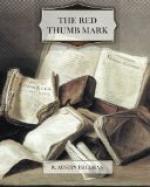“Do you say that—having regard to the facts which you have stated—it is certain that the red thumb-mark is a forgery?”
“I do; and I also say that it is certain that the forgery was executed by means of the ‘Thumbograph.’”
“Might not the resemblances be merely a coincidence?”
“No. By the law of probabilities which Mr. Singleton explained so clearly in his evidence, the adverse chances would run into untold millions. Here are two thumb-prints made in different places and at different times—an interval of many weeks intervening. Each of them bears an accidental mark which is due not to any peculiarity of the thumb, but to a peculiarity of the paper. On the theory of coincidences it is necessary to suppose that each piece of paper had a loose fibre of exactly identical shape and size and that this fibre came, by accident, in contact with the thumb at exactly the same spot. But such a supposition would be more opposed to probabilities even than the supposition that two exactly similar thumb-prints should have been made by different persons. And then there is the further fact that the paper found in the safe had no loose fibre to account for the mark.” “What is your explanation of the presence of defibrinated blood in the safe?”
“It was probably used by the forger in making the thumb-print, for which purpose fresh blood would be less suitable by reason of its clotting. He would probably have carried a small quantity in a bottle, together with the pocket slab and roller invented by Mr. Galton. It would thus be possible for him to put a drop on the slab, roll it out into a thin film and take a clean impression with his stamp. It must be remembered that these precautions were quite necessary, since he had to make a recognisable print at the first attempt. A failure and a second trial would have destroyed the accidental appearance, and might have aroused suspicion.”
“You have made some enlarged photographs of the thumb-prints, have you not?”
“Yes. I have here two enlarged photographs, one of the ‘Thumbograph’ print and one of the red thumb-print. They both show the white mark very clearly and will assist comparison of the originals, in which the mark is plainly visible through a lens.”
He handed the two photographs up to the judge, together with the ‘Thumbograph,’ the memorandum slip, and a powerful doublet lens with which to examine them.




